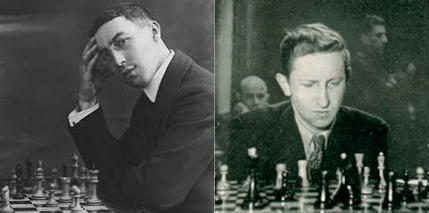
Intuition and the Invisible Thread
The art of Positional Chess is passed on from generation to generation. In this blog post we will see the invisible thread that unites Rubinstein, Smyslov and Anand, in their treatment of the Meran Variation, but also in some general patterns.
Chess is like an Ocean, almost infinite in its possibilities, and hiding numerous jewels. Once in a while a Grandmaster will show us one of those jewels, a Truth from that great Ocean, and we gasp collectively in wonder, and some of that Truth becomes a part of us, and can remain hidden, until something stirs our own small waters, and the remembrance of the jewel makes us find a similar truth.
We start our journey with one of Rubinstein's most famous games; perhaps the most famous of all! Rotlewi-Rubinstein, Lodz 1907.
Luckily for us, the game has commentaries by Karl Schlechter and Savielly Tartakower, bith great Masters in their own right!
A masterpiece, showing the energy that is latent in the solid Queen's Gambit Declined! The move ....c5 and the activation of Black's bishop on the a8-h1 diagonal have become the landmarks of Black's play in this type of positions!
 Akiba Rubinstein (1880-1961)
Akiba Rubinstein (1880-1961)
The next game is by Vassily Smyslov. Smyslov was born in 1921, and the game is from 1935. It is a very significant game! Smyslov was only 14 years old!


In his book, "Timman's Titans", Jan Timman writes about this game....
"When he was already in his eighties, he (Smyslov) confessed to Sosonko that he considered the game against Gerasimov to be the best of his entire career. The first published game was the best! When you are that old, nostalgic feelings may easily get the upper hand. However, this also shows that Smyslov, who was generally hailed as an endgame virtuoso, had a great fondness for attacks on the king. This corresponds with Hubner's opinion; he regarded Smyslov primarily as an attacking player."

In Part II of "My Great Predecessors", Smyslov credits his father, who was a chess Master.
"He instilled in me a love for so-called "simple" positions, with the participation of only a few pieces. I was able to gain a deep feeling for what each piece is capable of, to sense their peculiarities, their strength and impotence in various different situations on the board, the limits of their capabilities, what they "like" and what they "don't like" and how they behave....Such a "mutual understanding" with the pieces enables a player to see that which often remains concealed to purely logical analysis. It is then that the innate ability of a player, which I call a sense of harmony, manifests itself."
Here is a game in which Smyslov's father defeats Alexander Alekhine in a tournament in 1912!
Now the next game, although it was not the first time that Rubinstein played this variation, it is the instance that made it famous, and the reason it is called the Meran.....it is named after the town of Merano, where this tournament was held in 1924!
Take a look how Rubinstein makes Grunfeld look bad!
World-class chessplayers pass ideas to one another, much like the passing of a baton in a relay run.
In the following two games, Anand wins against Kramnik in their 2008 World Championship Match!
The following two games have a tactical theme in common. The first game, Aronian-Anand, from Tata Steel 2013, is shown because it is another example of how Anand is able to carry Rubinstein's idea to its maximum expression. The game is a masterpiece! And we have a video of Anand analyzing it! Hold on to your seats!